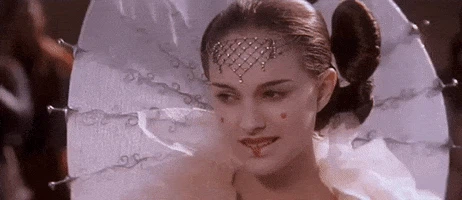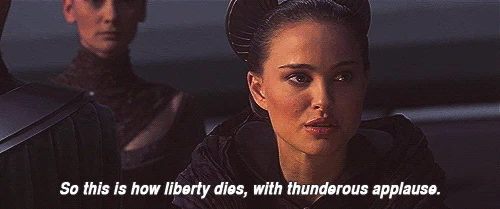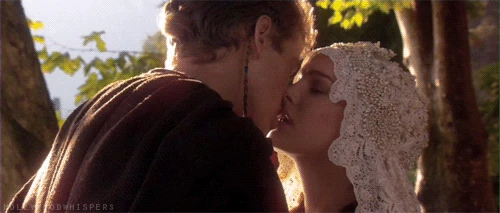Padme And Leia Are Girl Power The Way It Was Meant To Be
The ladies of Star Wars just simply don’t get enough attention. They’re badass without being whiny, and strong without being masculine.

In honor of May the Fourth, I declare this a day to celebrate the badass ladies of Star Wars (no, I’m not counting Rey). We’re talking the OG girls — Princess Leia and her mother, Padme Amidala. Both women exemplify strength and leadership while staying true to their gentler, feminine sides. They’re the type of ladies we wish we saw more in film, rather than the never-ending parade of monotonous “empowered women” we get nowadays.
Usually, it’s the men of Star Wars who get a lot of attention. Psychologists love to analyze the scene of Luke confronting the ghost of his father in the swamp. Han Solo is a plain heartthrob. Anakin, later Darth Vader, is one of the most famous villains of all time with a fascinating redemption story. While the saga is centered around a father-son legacy, the story’s themes of bravery, temptation, and resistance to tyranny and chaos are not limited to just men.
Padme and Leia are central characters, not just love interests or pretty faces.
After all, in both the originals and the prequels, one-third of the famous trio is a woman. Padme and Leia are central characters, not love interests or pretty faces there for the enjoyment of a mostly male audience. It would be have been easy to make Leia agreeable, to make Padme simply a pretty love interest. But both are given a complex journey of their own to conquer.
Padme’s Journey from Girl Queen to Leader of the Resistance
When we first meet Padme, she’s a girl of only 14 years who has somehow been elected queen of her native planet. (They apparently have a habit of electing young women as leaders, as the two subsequent leaders we see on Naboo were also young women.) Though young, she’s savvy and unafraid to stand up to the tyrannical invaders threatening her planet. When their escape ship lands on Tatooine for repairs, it would have been much easier and safer for her to remain on the ship. But instead, she chooses to disguise herself as a handmaiden in order to keep an eye on the Jedi and learn about the mysterious new planet.

When we meet her in the second film, Padme has matured from a strong but perhaps naïve queen to a senator who understands that her idealism about democracy is not shared by the majority of her counterparts. In fact, she has become a thorn in the side of the Chancellor, who is working to actively undermine the Senate. (Unfortunately, most of Padme’s most powerful scenes in the Senate are actually deleted scenes, and I would recommend checking them out if you’d like a full portrait of her character.)

She’s such a powerful anti-war advocate that the Chancellor attempts to have her assassinated to get her out of the way. She’s forced to go into hiding, although that doesn’t stop her from still trying to thwart her then-unknown enemy’s plans. She isn’t cowed by the start of the Clone Wars, and by the third episode, she’s revealed to be the founder of the early Rebel Alliance, along with Leia’s future adoptive father, Bail Organa.
The Power of Sacrifice
While Padme is obviously a political force to be reckoned with, she can’t banish her desire for love and motherhood. Again, sadly most of Padme’s character development is shown in deleted scenes, but one in Episode II shows her volunteering to help refugees before she was elected queen. She has a soft spot for the weak and helpless, which is why she first forms an attachment to Anakin. Later, this desire is shown through her fight to save the galaxy from the tyrannical rule of the increasingly power-hungry Chancellor.

She’s prepared to give up her own desires for love, family, and motherhood in order to fight to protect those who can’t protect themselves. Yet the intense dangers that she and Anakin face together forge a strong bond between them, and she eventually gives in and marries him secretly. This marriage results in her becoming pregnant, and now her own fears about the fate of their children are intermingled with her fears about the future of their Republic.

Tragically, it’s her own husband who’s responsible for the downfall of the Republic she worked so hard to defend and for her own death in childbirth. Although defeated in every possible way, Padme stays alive long enough to deliver her children safely. Even Anakin’s betrayal doesn’t destroy her faith in him, as she proclaims her faith that he can still be redeemed.

Anakin’s betrayal and the destruction of everything she had worked to defend could have turned Padme into a wrathful, resentful villain like Anakin. But instead, she chooses sacrifice and forgiveness as her last acts. By saving her children and entrusting her daughter to one of her rebel allies, she guarantees the future salvation of her beloved galaxy.
Leia Was a Feminist before Her Time
By any modern measure, Leia fits the mold of the “empowered woman.” She’s in a position of power. She isn’t waiting around for the men to save her. She’s resourceful and ready for a fight. Yet her character doesn’t fall into the tired trope of trying to be a man. Her character is first introduced as a sardonic, girl-power hero in the first film, but she develops into a gentler, more loving version of her younger self by the end of the trilogy.

From the very beginning, Leia has a strong sense of what’s right and wrong and is willing to die to defend what she believes to be right. She’s only 18 in A New Hope, yet like her mother, she’s already serving as an emissary for her planet in the Imperial Senate. She endures torture and witnesses the destruction of her home planet but never betrays the secrets of the Rebel Alliance.

Her strength and resolve allow her to take over the Rebel Alliance after the death of her father and grow its ranks even as the Empire seeks to destroy it. It’s not really given fanfare in the series, since we’re mostly focused on Luke’s journey toward becoming a Jedi, but Leia has been quietly running and growing the Rebel Alliance the entire time Han is having moral crises and Luke is whining about his training with Yoda. She endures her suffering and duties with much less drama than Luke, who is constantly overwhelmed by the task laid before him.
Leia Inspires Han To Become a Hero
Leia’s romance with Han upends a lot of Hollywood tropes about how a female character is supposed to behave when she falls in love. Although Han is a smooth talker who’s used to getting his way with women, it takes a lot more than that to impress Leia. First, she requires him to prove his bravery by fighting in the Death Star battle, rather than fleeing from it.

By the second film, Han’s short bout of bravery is almost done and he’s getting ready to return to his life of petty crime. But the attack on the rebel base forces Han to help Leia escape again, which he does reluctantly. And even this is not enough to earn her affection (although she’s starting to give in to it). No, it’s only when Han shows himself willing to sacrifice himself with dignity for her and Chewie’s safety that she’s willing to admit her feelings.

Her refusal to give in to Han’s two-bit flirting routine forces him to become a better man in order to deserve her. The parlor tricks he’s used to using on other women aren’t good enough, and he has to become a real hero capable of bravery and sacrifice before he earns her love. That’s why we love their romance so much — because women like Leia can inspire a man to become greater through their own strength and virtue.
Balancing Femininity and Strength
Writers nowadays equate being a strong female character with being able to do whatever a man can do. In fact, the story usually is that the woman is actually secretly better at whatever the man is doing, as long as she’s given the chance.
This narrative is destructive for two reasons. First, it implies that feminine qualities are weak, while masculine qualities are desirable. Second, it leaves strong women with no truly strong men to back them up. After all, if women are better at everything than men, why should we care about admiring strong men? Just get a woman to do it.
Their feminine qualities of courage, kindness, generosity, and compassion are what make them great leaders.
While neither Padme nor Leia is a shrinking violet, they’re not portrayed as man-hating feminists either. Both women rely on the honorable men around them for protection and help. They’re also allowed to demonstrate the feminine sides of their characters without being portrayed as weak or helpless. Instead, their feminine qualities of courage, kindness, generosity, and compassion are what make them great leaders.
Closing Thoughts
Padme and Leia both embody feminine strength as it ought to be shown. Although they never meet, Padme’s legacy of bravery and strength shines through in her daughter. They’re allowed to be feminine without being weak and strong without being hardened. Padme displays her feminine strength by protecting the weak and sacrificing herself to save her children. Leia carries on her legacy, fighting for freedom and compassion in a ruthless world. Neither allows their spirit of hope to be defeated, even in the face of certain defeat.
Now that’s what I call a heroine.
We want to know what you think about Evie! Take the official Evie reader survey.